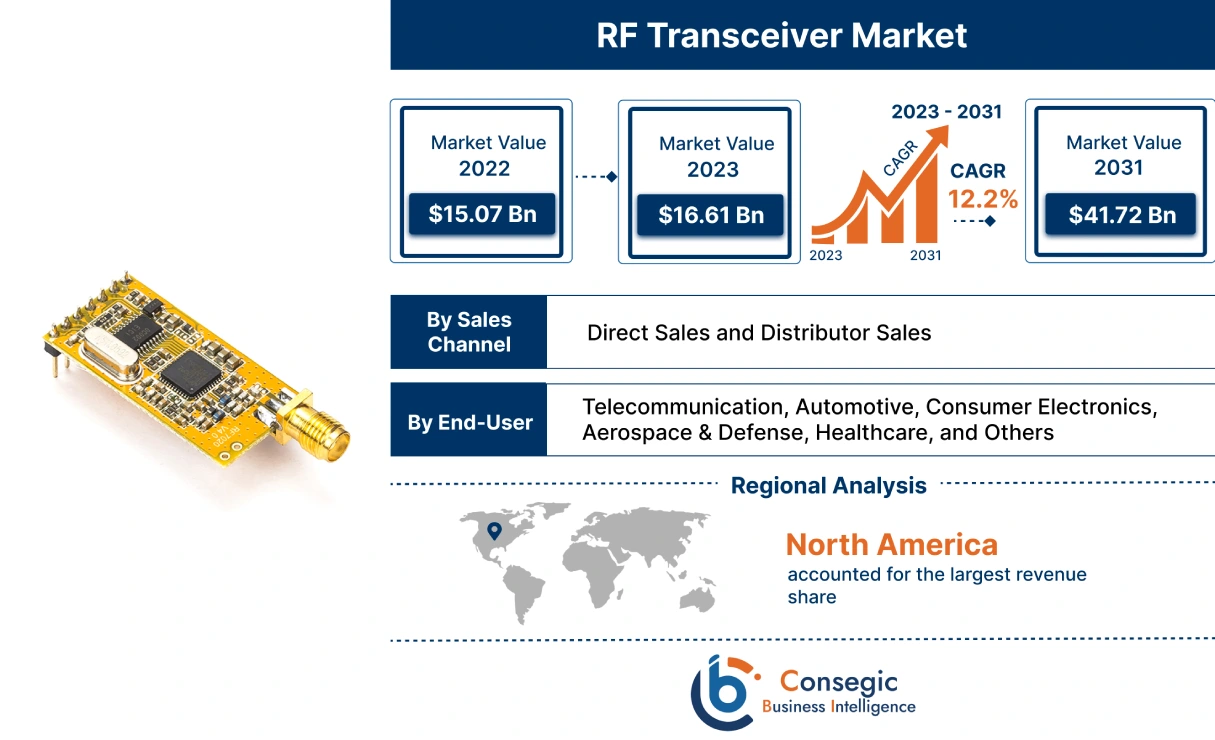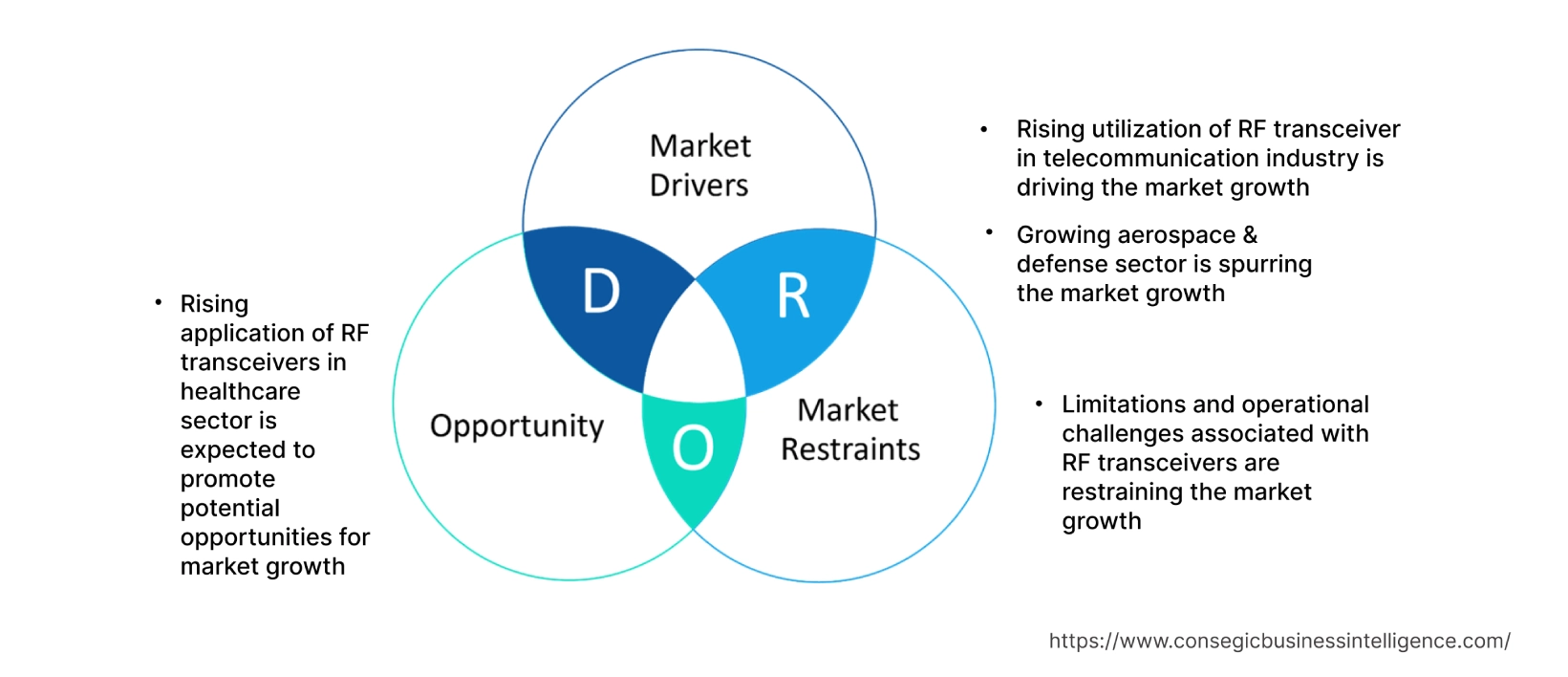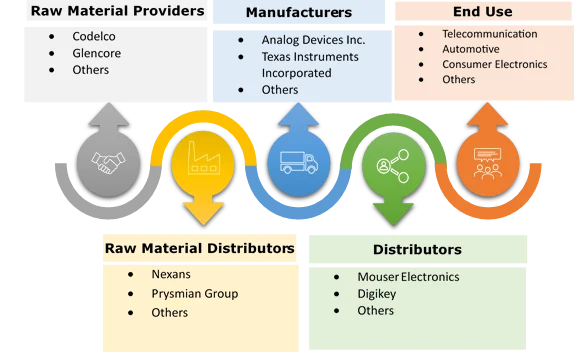RF Transceiver Market Size:
RF Transceiver Market size is estimated to reach over USD 41.77 Billion by 2032 from a value of USD 17.81 Billion in 2024 and is projected to grow by USD 19.50 Billion in 2025, growing at a CAGR of 12.45% from 2025 to 2032.
RF Transceiver Market Scope & Overview :
RF transceivers are integrated circuits that combine both a radio transmitter and receiver into a single device, enabling bidirectional wireless communication. They are crucial components in a wide array of wireless devices, including cell phones, Wi-Fi routers, and remote controls. RF transceivers are designed to transmit and receive radio frequency signals, allowing devices to both send and receive data or information. A typical RF transceiver includes a transmitter, receiver, oscillator, amplifier, and signal processing circuitry.
RF Transceiver Market Insights :
Key Drivers :
Growing Aerospace & Defense Sector is Boosting the Market Growth
RF transceivers are crucial components in aerospace and defense systems, enabling wireless communication and various other functionalities. They are used in applications such as satellite communication, radar systems, UAV data links, and soldier radios. These devices facilitate the transmission and reception of data, voice, and video signals over radio frequencies, making them essential for both military and civilian aerospace applications. RF transceivers are fundamental to satellite systems, enabling communication between ground stations and satellites for various purposes, including data transfer, voice communication, and GPS navigation.
- For instance, according to the International Air Transport Association, demand for global air passenger traffic, measured in revenue passenger kilometers, is expected to grow by 11.6% in 2024 compared with 2023. This shows the rising aerospace industry in turn driving the market growth.
Thus, the aforementioned factors are boosting the adoption of this transceiver in turn driving the market growth.
Key Restraints :
Limitations and Operational Challenges Associated with RF Transceiver are Hindering the Market Growth
RF transceivers, while crucial for wireless communication, face several limitations and operational challenges. These include interference from other RF devices, limited bandwidth, antenna design complexities, and issues related to signal propagation and attenuation, especially in densely populated or complex environments. Additionally, challenges arise from regulatory approvals, crosstalk between multiple radios, and the need for robust interference mitigation techniques.
Thus, the market analysis shows that the aforementioned factors are restraining the RF transceiver market demand.
Future Opportunities :
Innovations in Applications of RF Transceivers in Healthcare are Creating New Market Opportunities
RF transceivers, which combine both transmission and reception capabilities, are integral to various healthcare applications, enabling wireless communication for monitoring, diagnostics, and treatment. They are used in remote patient monitoring systems, implantable medical devices, telemedicine platforms, and medical device communication systems, facilitating real-time data transfer and remote care. RF transceivers are used in modern hearing aids for wireless communication between the device and other audio sources. RF transceivers are essential components in various wearable sensors for monitoring vital signs, physical activity, and other health parameters.
Thus, the ongoing advancements are projected to drive market opportunities during the forecast period.
RF Transceiver Market Segmental Analysis :
By Sales Channel :
Based on the sales channel, the market is bifurcated into direct sales and indirect sales.
Trends in the Sales Channel:
- The trend toward rising adoption of data analytics tools for leveraging the insights from data to understand customer preferences, track sales performance, and identify areas for improvement is driving the adoption of direct sales channels.
- The trend towards the rise of online platforms and digital marketplaces is fueling the demand for indirect sales channels.
Indirect Sales accounted for the largest revenue share in the year 2024.
- Indirect sale encompasses distributors, resellers, and system integrators working together to reach new markets and customers.
- Further, the proliferation of e-commerce websites such as eBay, Amazon, Alibaba, and others is paving the way for the growth of indirect sales channels.
- Furthermore, the key advantages of indirect sales channels include wider market reach, reduced costs, and access to specialized expertise.
- For instance, Mouser Electronics Inc., Arrow Electronics Inc., and others are some of the distributors of RF transceivers manufactured by Analog Devices Inc. and NXP Semiconductors, which in turn helps to cater demand in the global market.
- Thus, according to the RF transceivers market analysis, the proliferation of e-commerce websites is driving the market progress.
Direct Sales is anticipated to register the fastest CAGR during the forecast period.
- A direct sales channel refers to the process where products or services are sold directly to the end customer without any intermediaries such as wholesalers or retailers.
- Additionally, the primary advantages of direct sales channels include enhanced customer relationships, greater control over the sales process, and opportunities for increased income and flexibility.
- Further, the businesses leveraging direct sales channels are leveraging online platforms for selling goods and services directly to customers through its company websites.
- Furthermore, businesses and customers leverage direct sales channels is due to faster response time, higher product quality, competitive pricing, competitive pricing, and others.
- Therefore, according to the RF transceivers market analysis, the aforementioned factors are anticipated to boost the market during the forecast period.
By End-User :
Based on the end-user, the market is segregated into telecommunication, automotive, consumer electronics, aerospace & defense, healthcare, and others.
Trends in the End-User:
- The rising demand for miniaturized, flexible, efficient, and high-performance communication systems is driving the RF transceiver market trends.
- The increasing focus on developing transceivers that support multiple frequency bands and communication protocols is driving the adoption in the consumer electronics sector which in turn is fueling the RF transceiver market trends.
Telecommunication accounted for the largest revenue share of 31.6% in the year 2024.
- RF transceivers are fundamental components in telecommunications and are crucial for various applications, including smartphones, base stations, and satellite communication systems.
- Additionally, the growing deployments of 5G infrastructure are fueling the demand of the telecommunication industry which in turn is driving the RF transceiver market share.
- Further, the rising adoption of smartphones and advanced communication devices is propelling the demand for transceivers which in turn is fueling the RF transceiver market share.
- For instance, in April 2023, According to Viavi Solutions Inc., 5G connectivity has reached 47 of the world’s 70 largest economies by GDP. Additionally, 18 countries announced their first 5G deployments in 2022 which includes India and Mexico is paving the way for 5G development.
- Thus, as per the market analysis, the rising adoption of smartphones and advanced communication devices as well as 5G expansion is driving the market progress.
Aerospace & Defense is anticipated to register the fastest CAGR during the forecast period.
- RF transceivers are essential components in Aerospace and Defense to enable critical functions such as secure communications, radar, navigation, and electronic warfare.
- Additionally, the increasing production of air and maritime defense systems is driving the RF transceiver market size in the aerospace and defense sector.
- Further, the increasing demand for wideband transceivers is fueling the RF transceiver market size to enable seamless communication.
- Therefore, as per the market analysis, the increasing production of air and maritime defense systems is anticipated to boost the market during the forecast period.
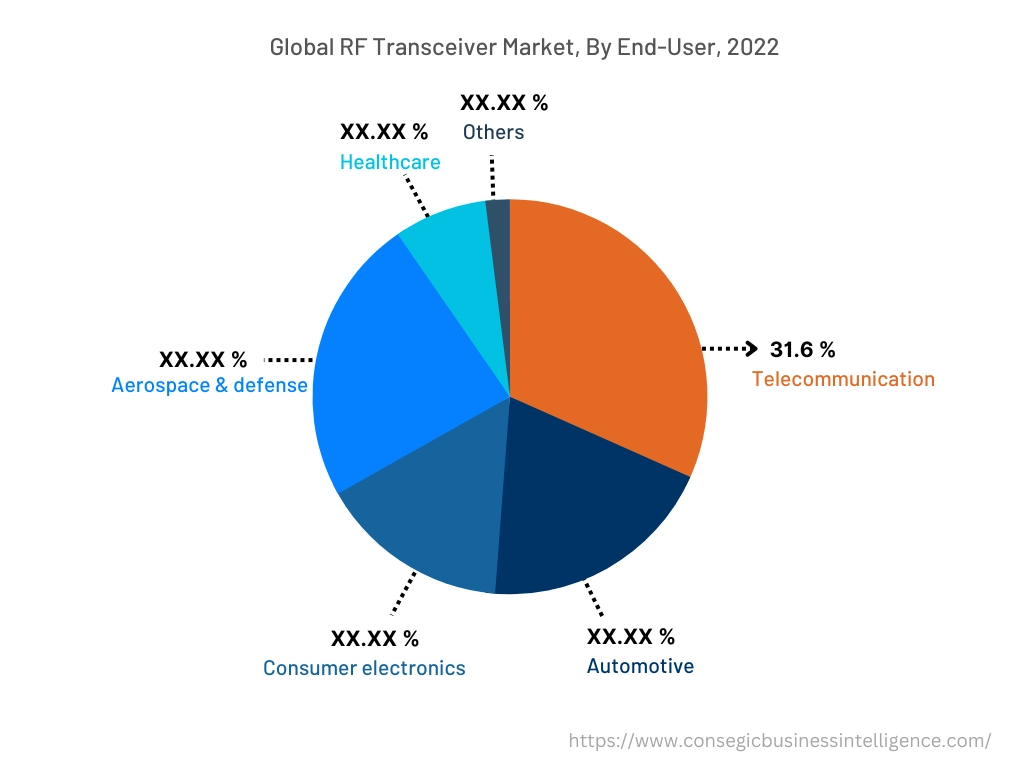
By Region :
The regions covered are North America, Europe, Asia Pacific, Middle East and Africa, and Latin America.
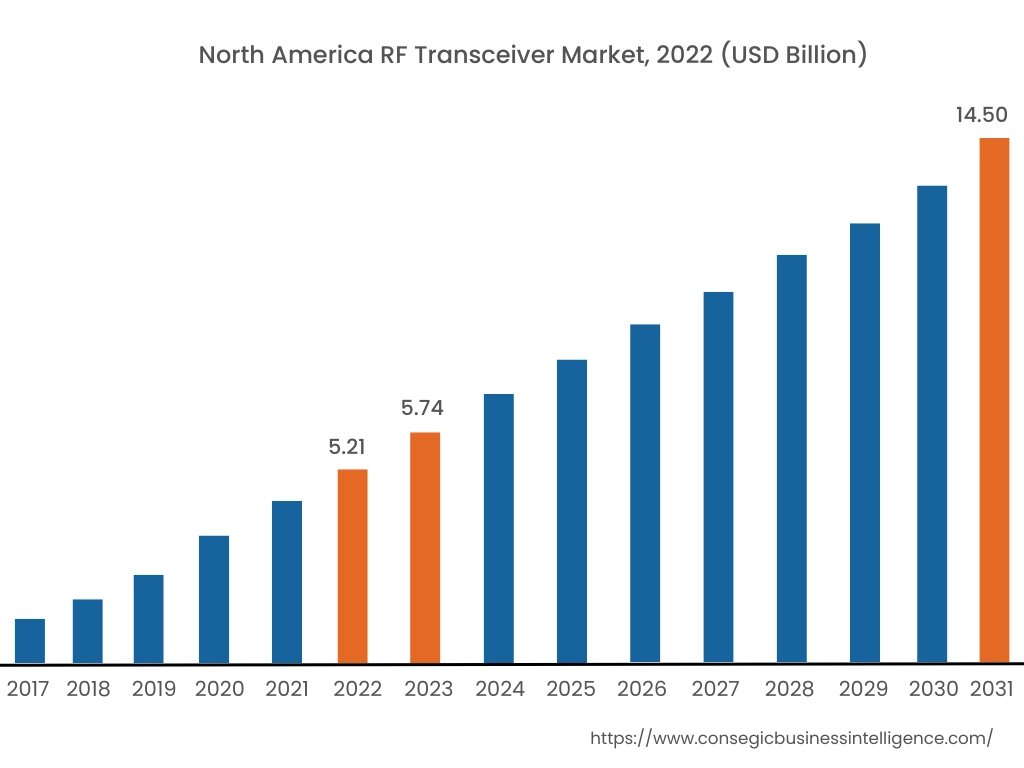
Asia Pacific region was valued at USD 4.60 Billion in 2024. Moreover, it is projected to grow by USD 5.05 Billion in 2025 and reach over USD 11.19 Billion by 2032. Out of this, China accounted for the maximum revenue share of 32.36%. The market growth is mainly driven by its deployment in consumer electronics, telecommunication, and other industries. Furthermore, factors including increasing penetration of 5G infrastructure and rising demand for smartphones are projected to drive the market progress in the Asia Pacific region during the forecast period.
- For instance, According to PIB, India, 773 out of 776 districts in the country including Lakshadweep have access to 5G services and 0.469 million 5G Base Transceiver Stations have been installed across India.
North America is estimated to reach over USD 12.89 Billion by 2032 from a value of USD 5.48 Billion in 2024 and is projected to grow by USD 6.00 Billion in 2025. The North American region's expanding 5G network and Internet of Things adoption offer lucrative growth prospects for the market. Additionally, the integration of transceivers with various applications such as IoT devices, smart homes, and automotive systems is driving market progress.
- For instance, According to GSMA, the North American mobile internet penetration rate reached 78% accounting for 313 million subscribers which in turn is paving the way for market adoption in the North American region.
The regional analysis depicts that the increasing demand for high-speed wireless communication as well as technological advancement in software-defined radios is driving the market in Europe. Additionally, the key factor driving the market is the increased infrastructure investment and the expanding adoption of wireless communication technologies such as 5G is propelling the market adoption in the Middle East and African region. Further, the increasing adoption of 5G technology and the expansion of digital services is paving the way for the progress of the market in the Latin America region.
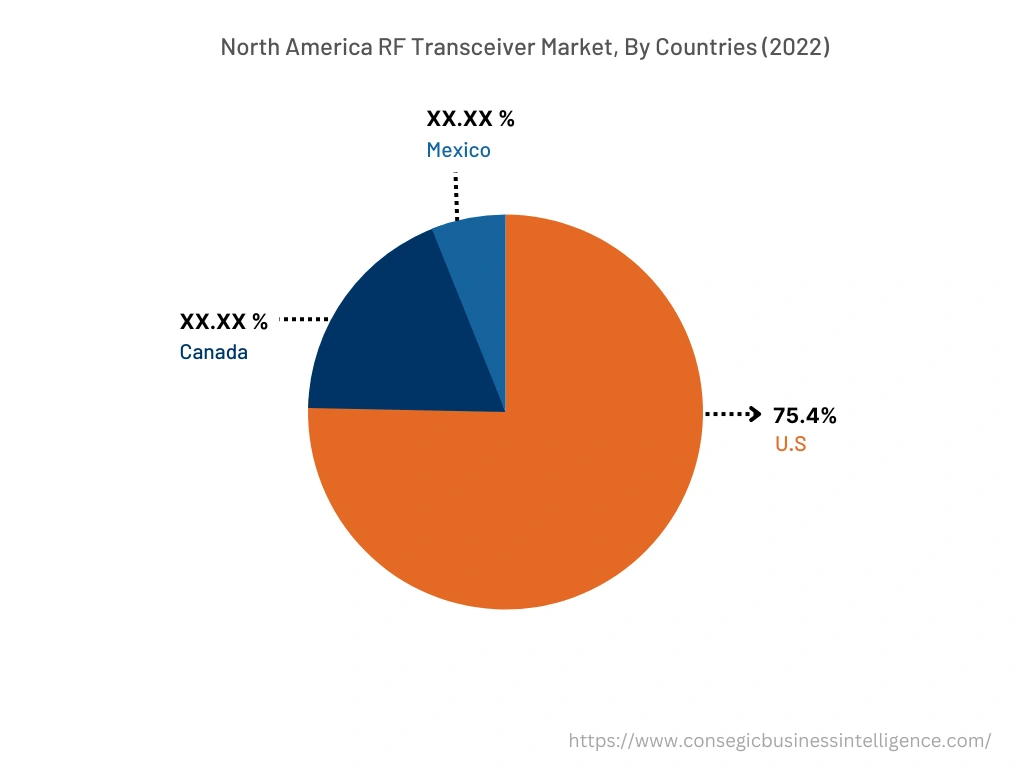
Top Key Players & Market Share Insights :
The RF transceiver industry is highly competitive with major players providing solutions and services to the national and international markets. Key players are adopting several strategies in research and development (R&D), product innovation, and end-user launches to hold a strong position in the global RF transceiver market. Key players in the RF transceiver industry include -
- Analog Devices Inc. (United States)
- Texas Instruments Incorporated (United States)
- Toshiba Electronic Devices & Storage Corporation (Japan)
- Infineon Technologies AG (Germany)
- STMicroelectronics (Switzerland)
- NXP Semiconductors (Netherlands)
- Renesas Electronics Corporation (Japan)
- Semiconductor Components Industries LLC (United States)
- Qualcomm Technologies Inc. (United States)
- Skyworks Solutions Inc. (United States)
RF Transceiver Market Report Insights :
| Report Attributes | Report Details |
| Study Timeline | 2019-2032 |
| Market Size in 2032 | USD 41.77 Billion |
| CAGR (2025-2032) | 12.45% |
| By Sales Channel |
|
| By End-User |
|
| By Region |
|
| Key Players |
|
| North America | U.S. Canada Mexico |
| Europe | U.K. Germany France Spain Italy Russia Benelux Rest of Europe |
| APAC | China South Korea Japan India Australia ASEAN Rest of Asia-Pacific |
| Middle East and Africa | GCC Turkey South Africa Rest of MEA |
| LATAM | Brazil Argentina Chile Rest of LATAM |
| Report Coverage |
|
Key Questions Answered in the Report
How big is the RF transceiver market? +
RF Transceiver Market size is estimated to reach over USD 41.77 Billion by 2032 from a value of USD 17.81 Billion in 2024 and is projected to grow by USD 19.50 Billion in 2025, growing at a CAGR of 12.45% from 2025 to 2032.
What are the major segments covered in the RF transceiver market report? +
The segments covered in the report are sales channel, end-user, and region.
Which region holds the largest revenue share in 2024 in the RF transceiver market? +
North America holds the largest revenue share in the RF transceiver market in 2024.
Who are the major key players in the RF transceiver market? +
The major key players in the market are Analog Devices Inc. (United States), Texas Instruments Incorporated (United States), Toshiba Electronic Devices & Storage Corporation (Japan), Infineon Technologies AG (Germany), STMicroelectronics (Switzerland), NXP Semiconductors (Netherlands), Renesas Electronics Corporation (Japan), Semiconductor Components Industries LLC (United States), Qualcomm Technologies Inc. (United States), Skyworks Solutions Inc. (United States).
